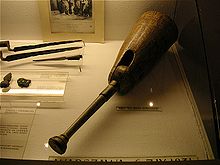Peg leg
Appearance

A pegleg is a prosthesis, or artificial limb, fitted to the remaining stump of a human leg. Its use dates to antiquity.[1]
By the late 19th century, prosthetics vendors would offer peglegs as cheaper alternatives to more intricate, lifelike artificial legs.[2] Even as vendors touted advantages of more complicated prostheses over simple peglegs,[2] according to a contemporary surgeon, many patients found a pegleg more comfortable for walking.[3] According to medical reports, some amputees were able to adjust to the use of a pegleg so well that they could walk 10, or even 30, miles in one day.[4]
Nowadays, wooden peglegs have been replaced by more modern materials, though some sports prostheses do have the same form.[5]
Notable pegleg wearers

Historical
- François Leclerc (~1554), privateer
- Cornelis Jol, (1597–1641), privateer and admiral of the Dutch West India Company
- Peter Stuyvesant (1612–1672), Dutch director-general of New Amsterdam [6]
- Blas de Lezo (1687–1741), Spanish admiral
- Gouverneur Morris (1752–1816), American politician
- Józef Sowiński (1777–1831), Polish 19th century general
- Vuk Karadžić (1787–1864), Serbian linguist
- Albert Chmielowski (1845–1916), Polish artist, founder of the Albertine Brothers and Sisters, saint of the Catholic Church
- Daniel Sullivan (~1871), Chicagoan
- Thomas L. "Pegleg" Smith (1801–1866), American prospector
- Robert McAlpin Williamson (1804? – December 22, 1859), nicknamed "Three-legged Willie", Republic of Texas Supreme Court Justice, state lawmaker, and Texas Ranger
- Clayton (Peg Leg) Bates (1907–1998), dancer
- Peg Leg Sam (Arthur Jackson) (1911–1977) American blues musician
- Dennis Collins, British sailor[7]
Fictional
- Alastor "Mad-Eye" Moody, character from the Harry Potter books and movies.
- Captain Ahab, character in Moby-Dick
- Barquentine (Gormenghast), character in Gormenghast.
- Fidget from The Great Mouse Detective.
- Hector Barbossa, a character in Pirates of the Caribbean: On Stranger Tides.
- Jonathan Small a character in the Sherlock Holmes story The Sign of the Four.
- Lucky Jack from Home on the Range.
- Pete, Disney's oldest recurring character.
- Russell from Happy Tree Friends.
- Seamus, a character in the American animated television series Family Guy who has two peglegs as well as two "peg arms".
- Silas Wegg, character in Our Mutual Friend by Charles Dickens
- Wirt, character in the computer games Diablo and Diablo II. His pegleg can be used to open the Secret Cow Level.
- Hiccup Horrendous Haddock III, character from the Dragons (e.g. How to Train Your Dragon) movies.
- Eli Vance, character in the computer game series Half-Life 2.
Railroads
- Bradford and Foster Brook Railway is also known as the "Peg Leg" from its wooden support piles.
- Fulton Chain Railroad is also known as the "Peg Leg" from its wooden rails.
References
- ^ Cantos, Mae (2005) "Pirates & Peg Legs: a Historical Look at Amputation and Prosthetics" In: Whitelaw, William A. (2005) (editor) Proceedings of the 14h Annual History of Medicine Days Faculty of Medicine, University of Calgary, Calgary, Alberta, pp. 16–20, OCLC 225558769, page 16
- ^ a b Marks, George Edwin (1888), A Treatise on Marks' patent artificial limbs with rubber hands and feet, A. A. Marks, p. 47
- ^ Tillmanns, Hermann (1895), Stimson, Lewis Atterbury (ed.), itle The principles of surgery and surgical pathology: general rules governing operations and the application of dressings, D. Appleton and company, p. 128
- ^ Teale, Thomas Pridgin (1858), On amputation by a long and a short rectangular flap, pp. 29, 31
- ^ Clarke, Carl D. (1965) Prosthetics Standard Arts Press, Butler, Maryland, OCLC 5083790, page 182
- ^ "...he lost his leg at Saint Martin.."
- ^ Mason, Christopher (21 September 2000) "At Home with Christopher Gibbs: A Parting Embrace For a Lifetimes Quirks" The New York Times, page 2 of electronic copy; for full details see Poole, Steve (2000) The politics of regicide in England, 1760-1850: troublesome subjects Manchester University Press, Manchester, England, pages 169-172, ISBN 0-7190-5035-9
Further reading
Books
- Murdoch, George and Wilson, A. Bennett (1998) A primer on amputations and artificial limbs C. Thomas, Springfield, Illinois, ISBN 0-398-06800-3
- Pitkin, Mark R. (2009) Biomechanics of Lower Limb Prosthetics Springer verlag, New York, ISBN 978-3-642-03015-4
- Seymour, Ron (2002) Prosthetics and orthotics: lower limb and spinal Lippincott Williams & Wilkins, Philadelphia, Pennsylvania, ISBN 0-7817-2854-1
- Warren, D. W. (2001) James Gillingham: surgical mechanist & manufacturer of artificial limbs Somerset Industrial Archaeology Society, Taunton, England, ISBN 0-9533539-5-8
Articles
- Bliquez, L. J. (1996) "Prosthetics in classical antiquity: Greek, Etruscan and Roman prosthetics" In: Haase, W. and Temporini, H. (editors) (1996) Aufstieg und niedergang der Römischen welt II Walter de Gruyter, Berlin, pp. 2640–2676
- Cantos, Mae (2005) "Pirates & Peg Legs: a Historical Look at Amputation and Prosthetics" In: Whitelaw, William A. (2005) (editor) Proceedings of the 14h Annual History of Medicine Days Faculty of Medicine, University of Calgary, Calgary, Alberta, pp. 16–20, OCLC 225558769
- Finch, J. (2011) "The ancient origins of prosthetic medicine" Lancet 377(9765): pp. 548–549
- Padula, Patricia A. and Friedmann, Lawrence W. (1987) "Acquired Amputation and Prostheses Before the Sixteenth Century" The Journal of Vascular Disease 38(2 Pt. 1): pp. 133–141, doi:10.1177/000331978703800207
- Reeves, Nicholas (1999) "New lights on ancient Egyptian prosthetic medicine" In: Davies, W. V. (editor) (1999) Studies in Egyptian Antiquities. A Tribute to T.G.H. James British Museum Press, London, pp. 73–77, ISBN 0-86159-123-2
- Thurston, Alan J. (2007) "Paré and prosthetics: the early history of artificial limbs" ANZ Journal of Surgery 77(12): pp. 1114–1119, doi:10.1111/j.1445-2197.2007.04330.x
- Wilson, Philip D. (1922) "Early weight-bearing in the treatment of amputations of the lower limbs" The Journal of Bone and Joint Surgery 4: pp. 224–247
